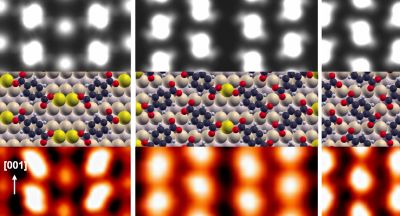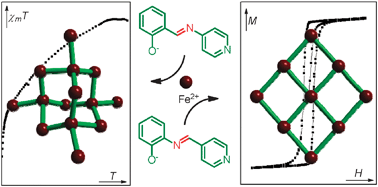News
Quadruple hydrogen bond polymer colloids HIPE up gels
Scientists in the team of assoc. prof. Stefan Bon (BonLab) have developed a convenient route to organogels templated by high internal phase emulsions (HIPEs) of water droplets which they refer to as HIPE- gels. Key is the use of a waterborne polymer latex loaded with a multiple hydrogen bond (MHB) array functionality - here 2-ureido-4[1H] pyrimidinone (UPy). Upon contact with an organic phase is a good solvent for the polymer (by shaking), swelling, and subsequent partial disentanglement of polymer chains originating from and wrapped up in the form of a latex particle, and phase transfer of polymer into the organic phase occurs. This process promotes the formation of a cross-linked swollen network in the form of an organogel through quadruple hydrogen bond interactions. Typically a HIPE-gel formulation contains 85vol% dispersed water droplets in 15vol% toluene at an original loading of 0.1wt% of UPy-functionalized latex particles in the water phase. They demonstrate that the HIPE-gels can be used as a soft matter storage and slow release material. The closed-cell compartmentalized water droplets remain intact upon submersion of the HIPE-gel into water, even under high osmotic pressure gradients. Upon drying the HIPE-gel a self-supporting porous monolith is obtained. They believe that the approach to the fabrication of the HIPE gels opens routes for potential applications in medical injectable gels, pressure sensors, and other interesting multiphase soft matter materials.
The work is published in chemical communications, link
More on the BonLab, link
‘Left-handed iron corkscrews’ point the way to new weapon in battle against superbugs like MRSA

 Scientists at the University of Warwick have taken inspiration from corkscrew structures found in nature to develop a new weapon in the fight against infections like E-coli and MRSA.
Scientists at the University of Warwick have taken inspiration from corkscrew structures found in nature to develop a new weapon in the fight against infections like E-coli and MRSA.
Researchers have created a new synthetic class of helix-shaped molecules which they believe could be a key tool in the worldwide battle against antibiotic resistance. By twisting molecules around iron atoms they have created what they term ‘flexicates’ which are active against MRSA and E-coli - but which also appear to have low toxicity , reducing the potential for side effects if used in treatment. The work is published in Nature Chemistry.
The new structures harness the phenomenon of ‘chirality’ or ‘handedness’ whereby the corkscrew molecules could be left-handed or right-handed. By making the most effective ‘hand’ to attack a specific disease, the University of Warwick research paves the way towards a more targeted approach to killing pathogens. In the case of E-coli and MRSA, it is the left ‘hand’ which is most effective.
Professor Peter Scott of the University of Warwick’s chemistry department said although this particular study concentrated on flexicates’ activity against MRSA and E-coli, the new method of assembly could also result in new treatments for other diseases.
“It’s a whole new area of chemistry that really opens up the landscape to other practical uses. These new molecules are synthetically flexible, which means that with a bit of tweaking they can be put to use against a whole host of different diseases, not just bugs like MRSA which are rapidly developing resistance to traditional antibiotics. Flexicates are also easier to make and produce less waste than many current antibiotics.”
Scientists have long been able to copy nature’s corkscrew-shaped molecules in man-made structures known as helicates – but they have thus far not been able to use them in fighting diseases. One of the key issues is the problem of handedness. Sometimes ‘left-handed’ molecules in drugs are the most effective at combating some disease, while sometimes the ‘right-handed’ version works best. Until now, scientists working with helicates have found it difficult to make samples containing just one type of corkscrew; either the right- or left-handed twist.
With flexicates, the University of Warwick scientists have succeeded in making samples containing just one type of twist – resulting in a more targeted approach which would allow the drug dosage to be halved. Flexicates solve other problems encountered by helicates, as they are easier to optimise for specific purposes, are better absorbed by the body and are easier to mass-produce synthetically.
Professor Scott said: “Drugs often have this property of handedness - their molecules can exist in both right and left handed versions but the body prefers to use only one of them. For this reason, drug companies have to go to the trouble of making many traditional molecules as one hand only. What we have done is solve the ‘handedness’ problem for this new type of drug molecule. By getting the correct hand we can halve the drug dose, which has the benefits of minimising side effects and reducing waste. For patients, it’s safer to swallow half the amount of a drug. Our work means that we can now make whichever hand of the corkscrew we want, depending on the job we require it to do.”
Notes to editors
The study, entitled Optically pure, water-stable metallo-helical ‘flexicate’ assemblies with antibiotic activity, is published in Nature Chemistry.
The research was also supported financially by EPSRC.
It is authored by Peter Scott, Suzanne Howson, Guy Clarkson and Alison Rodger from the University of Warwick, Albert Bolhuis from the University of Bath and Viktor Brabec and Jaroslav Malina from the Academy of Sciences of the Czech Republic.
When the paper is published it can be retrieved at http://dx.doi.org/10.1038/NCHEM.1206
Contact details
Professor Peter Scott is available on +44 (0) 24 7652 3238 or peter.scott@warwick.ac.uk
University of Warwick press officer Anna Blackaby is available on + 44 (0) 2476 575910 or + 44 (0)7785 433155 or a.blackaby@warwick.ac.uk
Front Page Artwork by Elisabeth Heissler http://ehgraphicdesign.co.uk/
At surfaces it's different
Costantini and collaborators have reported in a special themed issue of Chemical Communications about a novel chemical pathway observed only in the presence of a metal substrate. In solution chemistry, assuming no kinetic limitations, the thermodynamic product is formed independently of the absolute reactant concentration. However, inclusion of a metallic substrate introduces a further variable which ultimately defines the chemistry observed. In their recent work, terephthalic acid was deposited onto a Cu(110) substrate, where, at low surface coverages, 2-dimensional metal-organic structures form. However, with increasing coverage, the interaction between molecule and metal induces the formation of a denser, less energetically-favoured hydrogen-bonded network.
The article can be read here .
.

Simple compounds, hard magnets
New magnetic materials have been created from simple components by Lihong Li, a Warwick Postgraduate Research Fellow and co-workers in the Scott group at Warwick University. The resarchers have engineered magnetic diamond-like 3D networks and layered 2D net structures. A rare example of a molecular hard magnet (which like a regular magnet keeps its magnetic properties over time) is produced. The chemistry is simple, reliable and scalable so the group hope to make many new materials in the future for applications in data storage, and quantum computing. The work is published in Chemical Communications.
Size is Key Parameter in 'Smart Nanoparticles'
Gibson  and O'Reilly groups have published a manuscript in Chemical Communications which demonstrate the critical importance of nanoparticle diameter on its thermo-responsive behaviour, as demonstrated using a panel of gold and self-assembled polymer nanoparticles. These findings have implications for the rationale design of 'smart' nanomaterials for biotechnological applications.
and O'Reilly groups have published a manuscript in Chemical Communications which demonstrate the critical importance of nanoparticle diameter on its thermo-responsive behaviour, as demonstrated using a panel of gold and self-assembled polymer nanoparticles. These findings have implications for the rationale design of 'smart' nanomaterials for biotechnological applications.
Fabrication of clay armored "soft" polymer latexes through Pickering emulsion polymerization
The BonLab reports on the fabrication of “soft” nanocomposite clay armored polymer latexes with their latest work published in the ACS journal Macromolecules.
Laponite clay XLS is used as stabilizer in the Pickering emulsion polymerization of a variety of monomer mixtures, that is, methyl methacrylate and n-butyl acrylate, styrene and n-butyl acrylate, and styrene and 2-ethylhexyl acrylate. Overall solids contents of the hybrid latexes in complete absence of coagulation of up to 24 wt % are reported under batch conditions. Key mechanistic aspects of the Pickering emulsion polymerization process are discussed. The use of monomers that have high water solubility and are prone to hydrolyze under basic conditions, for example methyl methacrylate, should be restricted. The use of small amounts of methacrylic acid as auxiliary monomer promotes clay adhesion to the surface of the particles in the Pickering emulsion (co)polymerization of hydrophobic monomers. Detailed kinetic studies at both 60 and 80 °C of the Pickering emulsion copolymerization of styrene and n-butyl acrylate (Sty:BA = 0.67 w/w) are reported, with varying amounts of Pickering stabilizer. The Laponite clay discs play a crucial role in the particle formation (nucleation) stage of the Pickering emulsion polymerization process. Use of increasing amounts leads to smaller average particle sizes but inflicts longer nucleation periods, thereby broadening the particle size distributions. We report the occurrence of a catastrophic coagulation phenomenon for Pickering emulsion polymerizations carried out at a low initiator (ammonium persulfate) flux at 60 °C, for a small window of concentrations of Laponite clay discs.
Read the paper: http://dx.doi.org/10.1021/ma201691u
More info on the BonLab: http://www.bonlab.info
High density of metal atoms in Si surface alloys essential for 2D supramolecular assembly
Costantini and collaborators report on the importance of metallic atoms in Si surface alloys for their use as effective substrates for 2D supramolecular self-assembly.
Scanning tunnelling microscopy is used to compare the assembly properties of terephthalic acid on two Bi-Si surface alloys with different metallic surface density. Results published in Surface Science show that, besides the absence of semiconductor dangling bonds, also a high density of Bi surface atoms is essential to smoothen the energy landscape experienced by adsorbed molecules and therefore promote their diffusion and assembly. More at http://www.sciencedirect.com/science/article/pii/S0039602811003177
Precious metal materials
Walton’s group, in collaboration with colleagues in the Department of Physics and at Johnson Matthey plc have a paper published this week in the RSC journal Chemical Science: this describes mild synthetic chemical routes to complex extended structures that contain the metal iridium in various oxidation states. This illustrates the scope for the discovery of new functional materials by exploration of novel reaction conditions and using the chemistry of lesser studied elements.
http://pubs.rsc.org/en/content/articlelanding/2011/sc/c1sc00192b/
Cisplatin as a protein crosslinker
Cisplatin is the most widely used anti-cancer drug, and the side-effects of cisplatin chemotherapy are largely due to side reactions of cisplatin with other molecules in the body, chiefly proteins. In a joint publication between the O'Connor group and the Sadler group, it's reported that the anticancer drug, cisplatin, can act as a protein crosslinker which is of use in the field of proteomics. Cisplatin has novel features as a protein crosslinker: 1) it's charged, so it improves the sensitivity of any modified peptides over non-reacted peptides, 2) it targets methionine and histidine primarily, which are residues that are not targetted by traditional crosslinkers, 3) it has an unusual isotopic pattern compared to typical peptides or peptide crosslinkers, which can be used as a signature to flag those peptides which are modified with platinum, 4) it has a fixed arm-length of about 4.5 Angstroms, but has the potential for addition of other chemical moities to extend the arm-length. This observation allows new kinds of proteomics that focuses on those proteins which are modified by cisplatin directly - thus potentially profiling all molecules which are directly responsible for the deleterious side-effects in chemotherapy. This paper has just been published in Analytical Chemistry: http://pubs.acs.org/doi/abs/10.1021/ac200861k
Challis group and collaborators feature on the cover of Chemistry & Biology
The group of prof. Challis together with their collaborators feature on the cover of Chemistry & Biology.
Through screening of Burkholderia cepaciacomplex bacteria, Mahenthiralingam et al. (pp. 665–677) identified one species (Burkholderia ambifaria) that produces potent polyketide antibiotics called enacyloxins, using an unusual hybrid, cis-AT/trans-AT polyketide synthase. The findings suggest that Burkholderiabacteria are a promising resource for the discovery of new antibiotics, with unusual production pathways and potent activity against drug-resistant bacteria. The cover shows a TLC plate on which Burkholderiaculture extracts were fractionated, illustrating the diversity of antimicrobial secondary metabolites. After overlaying this plate with agar seeded with the yeast Candida albicans, secondary metabolites with antimicrobial activity are revealed by the zones of clearing. Classical plate inhibition assays with Burkholderiastrains demonstrating antagonistic activity against a range of bacteria and fungi as well as the structure of enacyloxin IIa are also shown
To read the paper: http://dx.doi.org/10.1016/j.chembiol.2011.01.020
First wood-digesting enzyme found in bacteria could boost biofuel production
Researchers funded by the Biotechnology and Biological Sciences Research Council (BBSRC)-led Integrated Biorefining Research and Technology (IBTI) Club have identified an enzyme in bacteria which could be used to make biofuel production more efficient. The research is published in the 14 June issue of the American Chemical Society journal Biochemistry.
This research, carried out by teams at the Universities of Warwick and British Columbia, could make sustainable sources of biofuels, such as woody plants and the inedible parts of crops, more economically viable.
The researchers, who were also supported by the Engineering and Physical Sciences Research Council, have discovered an enzyme which is important in breaking down lignin, one of the components of the woody parts of plants. Lignin is important in making plants sturdy and rigid but, because it is difficult to break down, it makes extracting the energy-rich sugars used to produce bioethanol more difficult. Fast-growing woody plants and the inedible by-products of crops could both be valuable sources of biofuels but it is difficult to extract enough sugar from them for the process to be economically viable. Using an enzyme to break down lignin would allow more fuel to be produced from the same amount of plant mass.
The researchers identified the gene for breaking down lignin in a soil-living bacterium called Rhodococcus jostii. Although such enzymes have been found before in fungi, this is the first time that they have been identified in bacteria. The bacterium's genome has already been sequenced which means that it could be modified more easily to produce large amounts of the required enzyme. In addition, bacteria are quick and easy to grow, so this research raises the prospect of producing enzymes which can break down lignin on an industrial scale.
Professor Timothy Bugg, from the University of Warwick, who led the team, said "For biofuels to be a sustainable alternative to fossil fuels we need to extract the maximum possible energy available from plants. By raising the exciting possibility of being able to produce lignin-degrading enzymes from bacteria on an industrial scale this research could help unlock currently unattainable sources of biofuels.
"By making woody plants and the inedible by-products of crops economically viable the eventual hope is to be able to produce biofuels that don't compete with food production."
The team at Warwick have been collaborating with colleagues in Canada at the University of British Columbia who have been working to unravel the structure of the enzyme. They hope next to find similar enzymes in bacteria which live in very hot environments such as near volcanic vents. Enzymes in these bacteria have evolved to work best at high temperatures meaning they are ideally suited to be used in industrial processes.
Duncan Eggar, BBSRC Sustainable Bioenergy Champion, said: "Burning wood has long been a significant source of energy. Using modern bioscience we can use woody plants in more sophisticated ways to fuel our vehicles and to produce materials and industrial chemicals. This must all be done both ethically and sustainably. Work like this which develops conversion processes and improves efficiencies is vital."
ENDS
Notes to editors
This paper is available online here: http://pubs.acs.org/doi/abs/10.1021/bi101892z
Tweakable chiral magnetic materials
Magnetic interactions between metal atoms in a family of chiral materials respond to subtle changes in their organic chemistry. The work forms part of the PhD research by Lihong Li in the Scott group in Warwick Chemistry department. Read the article at Inorg. Chem. 2011



